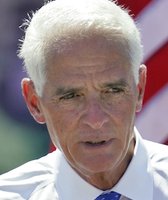Stand up for the facts!
Our only agenda is to publish the truth so you can be an informed participant in democracy.
We need your help.
I would like to contribute
SUMMARY: Sen. Hillary Clinton has promoted her plan to solve the foreclosure crisis with various freezes, but she sometimes leaves crucial details out of her public comments. Sen. Barack Obama, meanwhile, takes aim at the inflated rhetoric and misses.
With the public perception that the country is facing economic malaise, candidates are answering questions about the troubled housing market and presenting ideas for helping people hang on to their homes.
The roots of the problem stretch back several years to when the housing market was strong and banks were willing to issue more high-risk loans, known as subprime loans. A typical subprime borrower is a homeowner with bad credit, though a few are investors taking on higher-than-normal debt loads. Subprime loans have "teaser rates" that keep payments artificially low for a period. Then the loans reset to a significantly higher interest rate, which drives up people's monthly house payments.
In better years, homeowners could sell their home or refinance at a lower rate before the rates reset, said Angela Williams Foster, a University of Pittsburgh professor who studies the housing market and public policy. The problem now is that too many homes are for sale, it's difficult to sell a home, and banks are curbing their lending practices, making it tough to refinance. The result is that people are in danger of losing their homes, Foster said.
"Basically, people are unable to get out from under their house," she said.
Sign up for PolitiFact texts
The Center for Responsible Lending, a nonprofit research group, believes that 2.2-million homeowners with subprime mortgages could lose their homes to foreclosure in the next few years.
To solve the foreclosure problem, Sen. Hillary Clinton has proposed a detailed policy aimed at helping subprime homeowners. She regularly touts her policy as being more substantive and detailed than her opponent, Sen. Barack Obama.
"I am the only candidate left in this race with a comprehensive plan to address the foreclosure crisis," Clinton said recently.
Clinton's plan has several elements: She wants lenders to freeze foreclosures for 90 days on owner-occupied homes purchased with subprime mortgages. She wants lenders to freeze interest rates on subprime loans for owner-occupied homes for five years, or until homeowners can refinance. She wants to create a $30-billion fund for states to deal with the effects of foreclosures, everything from helping individual homeowners pay their bills to making up lost property tax revenues for police and firefighters.
Clinton believes lenders should voluntarily embrace the freezes she suggests as a means of preventing widespread defaults. She would not impose the freezes through the force of law.
Got all that? It's a detailed policy, and she has criticized Obama for having a less substantive position. Obama does not advocate the freezes Clinton suggests, but offers a similar fund for states and reforms for the lending process designed to increase transparency for home buyers.
The problem Clinton is running into on the campaign trail is that she regularly shorthands her terminology, giving the impression that her plan is broader than it is. Instead of saying she wants to freeze interest rates for subprime loans for owner-occupied homes, she has said only that she wants to freeze interest rates. Anyone with an adjustable rate mortgage might think her plan applies to them, when it doesn't.
For example, at a debate on Jan. 31, 2008, in California, Clinton said:
"I think it's imperative that we approach this mortgage crisis with the seriousness that it is presenting. There are 95,000 homes in foreclosure in California right now. I want a moratorium on foreclosures for 90 days so we can try to work out keeping people in their homes instead of having them lose their homes, and I want to freeze interest rates for five years."
The problem here is that lots of homeowners have adjustable rate mortgages, and not all of them are subprime borrowers. Nowhere did Clinton mention that the freezes only apply to owner-occupied homes bought with subprime loans.
Some of her direct-mail pieces also elide these caveats; check out examinations from Factcheck.org here and from the Atlantic Monthly here .
That vagueness has prompted criticism. Two economists wrote in the New Republic recently that they weren't clear what Clinton was proposing, and that some of her language suggested an interest rate freeze for every adjustable rate mortgage in the country. Such a widespread change to the mortgage industry would be foolhardy, argued economists Richard Thaler and Susan Woodward.
"Promising the American people that you can fix things by just lowering their interest rates is dishonest, a fairy tale that won't come true," they wrote.
Economist Laura Tyson, who served as Bill Clinton's national economic adviser, responded in defense of Clinton's plan, reiterating its details and saying that Thaler and Woodward distorted Clinton's proposal to make points.
"Her recommendations deserve serious discussion, not unsubstantiated attacks by scholars who should read her words more carefully than they apparently have," Tyson said.
Thaler and Woodward wrote again, saying that Clinton is the one who needs to be more careful in her public remarks. They also said that Clinton has offered a frustrating lack of specifics on how she would implement a largely voluntary plan.
Yes, it is easier for Clinton to say "freeze interest rates" than "freeze interest rates in owner-occupied homes purchased with subprime mortgages." But that doesn't make the short version accurate. (See our statement on this point here .)
Barack Obama, meanwhile, has launched counterattacks on Clinton's plan.
Campaigning in Texas, where a primary is scheduled on March 4, 2008, Obama said:
"She's proposed that we freeze the monthly rate on existing adjustable rate mortgages for at least five years. I disagree with that approach, although I'm sure it's well-intentioned. And here's why: It will reward people who made this problem worse. It will also reward people who are wealthy and don't need it. It won't just target the struggling homeowners who need help the most. And on top of that, a blanket freeze, as she's proposed, will drive rates through the roof on people who are trying to get new mortgages to buy or refinance a home."
Obama has this wrong. Clinton's plan isn't a "blanket freeze" on interest rates, only those for subprime loans on houses owned by the occupant, making it less likely to help wealthy investors, according to the housing experts we spoke to. It's important to correct the error in what's been said, but it's difficult to judge Obama's remarks too harshly because he has mischaracterized the Clinton plan in just the same way Clinton has.
Foster, the housing professor, said she thinks the proposed rate freeze is a good idea because it could keep subprime borrowers in their homes. She disagrees with Obama's criticism that the plan would help the wealthy. Most subprime homeowners are not people who tried to game the system for strictly financial gain, she said.
"That's a portion of the market, but it's not a large portion," she said. "It really is just someone who took out a loan and really didn't understand their loan. People are very anxious to own, and our research shows that people still don't really understand the products."
Another economist, Kenneth Thomas of the Wharton School, agreed that a freeze is unlikely to help the wealthy. "You can be wealthy and have poor credit, but generally that is not the case," he said.
But he opposes Clinton's plan and thinks Obama is correct that an interest-rate freeze would have the effect of driving up interest rates for new borrowers. Lenders would react to an interest-rate freeze by setting rates for new loans at a higher rate, he said.
"Whenever you freeze any interest rates or any rate that the market determines, what happens is it distorts the market, and market distortions generally result in problems," he said.
Thomas said the government should stay out of the foreclosure crisis, and let lenders and borrowers negotiate their own agreements.
"What's driving the foreclosure crisis is that the housing bubble has burst," he added. "There's really no quick fix solution."
Our Sources
CNN, Transcript of Democratic debate in Los Angeles , Jan. 31, 2008
CQ Transcripts, "Barack Obama delivers remarks at a campaign event," Feb. 19, 2008
The New Republic, Subprime , by Richard Thaler and Susan Woodward, Feb. 4, 2008
Hillary Clinton campaign Web site, Solutions for America: Economic Blueprint , Feb. 18, 2008
Hillary Clinton campaign Web site, Sen. Obama Launches Inaccurate Attack On Hillary's Plan To Curb Housing Crisis , Feb. 19, 2008
Hillary Clinton campaign Web site, Hillary Clinton Statement on Her New Legislation to Fight Foreclosures , Jan. 31, 2008
Hillary Clinton campaign Web site, Senator Hillary Rodham Clinton Remarks on Wall Street on Housing Crisis , Dec. 5, 2007
The New Republic, A Taxing Argument , by Laura Tyson, Feb. 15, 2008
The New Republic, Promises vs. Solutions , Feb. 15, 2008
Interview with Angela Williams Foster of the University of Pittsburgh
Interview with economist Kenneth Thomas
CNN, Candidates and their economic plans , Feb. 16, 2008













































